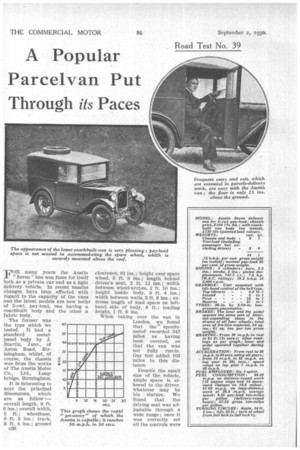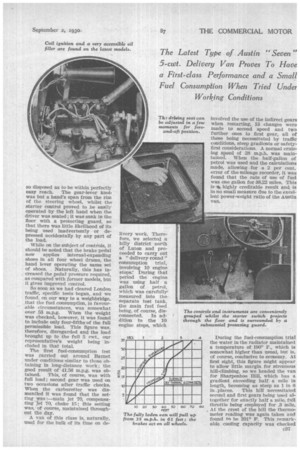A Popular Parcelvan Put
Page 58

Page 59

Page 60

If you've noticed an error in this article please click here to report it so we can fix it.
Through its Paces FOR many years the Austin " Seven " has won fame for itself both as a private car and as a light delivery vehicle. In recent months changes have been effected with regard to the capacity of the vans and the latest models are now bothf of 5-cwt. pay-load, one having a coachbuilt body and the other fabric body.
The former was . the type which we tested. It had a standard metalpanel boy by J. Startin, junr., of Aston Road, Birmingham, whilst, of course, the chassis was from the works — of The Austin Motor 15
40 55
so
2$
mu
Co., Ltd., Longbridge, Birmingham.
It is interesting to note the principal dimensions, which are as follow :overall length, 9 ft. 6 ins.; overall width, 5 ft.; wheelbase, 6 ft. 3 ins.; track, 3 ft. 4 ins.; ground c36 clearance, 8i ins.; height over spare wheel, 5 ft. 9 ins.; length behind driver's seat, 2 ft. 11 ins.; width between wheel-arches, 2 ft. 10 ins.; height inside body, 3 ft. 4 ins.; width between walls, 3 ft. 6 ins.; extreme length of load space on lefthand, side of body, 6 ft.; loading height, 1 ft. 9 ins.
When taking over the van in London, we found that the"speedometet recorded 345 miles as having been covered, so that the van was not fully run-in. Our test added 103 miles to this distance.
•
Despite the small size of the vehicle, ample space is allowed to the driver, whatever may be his stature. We o found that the driving seat was adjustable through a wide range ; once it was correctly set all the controls were so disposed as to be within perfectly easy reach. The gear-lever knob was but a hand's span from the rim of the steering wheel, whilst the starter control proved to be easily operated by the left hand when the driver was seated ; it was sunk in the floor with a protecting guard, so that there was little likelihood of its being used inadvertently or depressed accidentally by any part of the load.
While on the subject of controls, it Should be noted that the brake pedal now anplies internal-expanding shoes in all four wheel drums, the hand lever operating the same set of shoes. Naturally, this has increased the pedal pressure required, as compared with former models, but it gives improved control.
So soon as we had cleared London traffic, specific tests began, and we found, on our way to a weighbridge, that the fuel consumption, in favourable circumstances, was somewhat over 53 m.p.g. When the weight was checked, however, it was found to include only four-fifths of the full permissible load. This figure was, therefore, disregarded and the load brought up to the full 5 cwt., our representative's weight being included in that total.
The first fuel-consumption test was carried out around Barnet under conditions similar to those obtaining in long-distance work ; the good result of 41.56 m.p.g. was obtained. This, of course, was with full load ; second gear was used on two occasions after traffic checks. When the carburetter was dismantled it was found that the setting was :—naain jet 70, compensating jet 70, choke 15; this setting was, of course, maintained throughout the day.
A van of this class is, naturally, used for the bulk of its time on de
livery work. Therefore, we selected a hilly district north of Luton and proceeded to carry out a " delivery-round " consumption trial, involving 10 engine stops! During that period the engine was using half a gallon of petrol, which was carefullymeasured into the separate test tank, the main fuel feed being, of course, dis connected. In addition to the 10 engine stops, which
involved the use of the indirect gears when restarting, 13 changes were made to second speed and two 'further ones to first gear, all of these being necessitated by traffic conditions, steep gradients or safetyfirst considerations. A normal cruising speed of 28 m.p.h. was maintained. When the half-gallon of petrol was used and the calculations made, allowing for a 2 per cent. error of the mileage recorder, it was found that the rate of use of fuel was one gallon for 38.22 miles. This is 41, highly creditable result and is in no small measure due to the excellent power-weight ratio of the Austin van.
During the fuel-consumption trial the water in the radiator maintained a temperature of 190° F., which is somewhat higher than usual, but is, of course, conducive to economy. At first sight, this figure might appear to allow little margin for strenuous hill-climbing, so we headed the van for Sharpenhoe Hill, which has a gradient exceeding half a mile in length, becoming as steep as 1 in 6 in places. This hill necessitated second and first gears being used altogether for exactly half a mile, full throttle being employed for .3 mile. , At the crest of the hill the thermometer reading was again taken and found trrt be 201° P. This remarkable cooling capacity was checked
on other occasions during the day, and no amount of mal-treatment would raise the water above that temperature, go that users in hilly districts need fear no trouble on the score of cooling.
As regards pulling powers in general, it was found best to change down to second gear at about 25 m.p.h. in order to keep up the rate of engine revolutions when climbing long grades; the simplicity of the gear change permits this to be done with ease, once the short travel of the clutch pedal has been mastered. The lever is best handled with two lingers.
The maximum speeds on the various gears proved to be 15 m.p.h., SO m.p.h. and 45 m.p.h.; actually, the last-named figure was exceeded by 4 m.p.h. on one occasion, but conditions were then favourable to running the engine at a speed somewhat in excess of the peak of the power curve.
Our braking tests were, as usual, carried out on a level road having a first-class surface. The hand lever• and pedal were used in conjunction to obtain the minimum stopping distances. A pleasant feature of the retardation was the even braking on all four wheels and the fact that it was difficult to lock any one wheel, however fiercely the brakes were applied. This, of course, goes a long way towards providing safety, coupled with efficient braking. The high standard obtained is shown in the figures which go to form the basis of the graph reproduced in these pages.
Acceleration trials were also carried out on the same stretch of road, and the graph which we reproduce Is based upon the mean of a series of three runs, with and against the wind, so as to obtain true mean
readings. Naturally, the best results are obtained when full use is made of the gearbox, but, partially due to the use of coil-and-distributor ignition, extreme flexibility is obtained at low speeds. The engine is responsive to the ignition control, but does not knock easily.
As is to be expected with a vehicle weighing well under a ton, the steering is exceptionally light, and any youth of legal age could, in any circumstance, handle the vehicle with safety, so far as the physical side of the work is concerned. He might even be able to extricate the vehicle if ditched, by the simple process of lifting the partially sunk wheel and putting stones beneath it—no small advantage when on delivery work in desolate areas.
Despite its short wheelbase, the van holds the road well. We found that there Was no tendency to pitch on the rough stretch of road adSpent to Mill Hill Observatory. This road usually produces the uncomfortable result in question, but its absence in this case was apparently due to the large dampers for the front transverse springs.
Provided that the van was handled with due regard to reasonable road speed on corners, there was no tendency to roll on the springs.












































































































